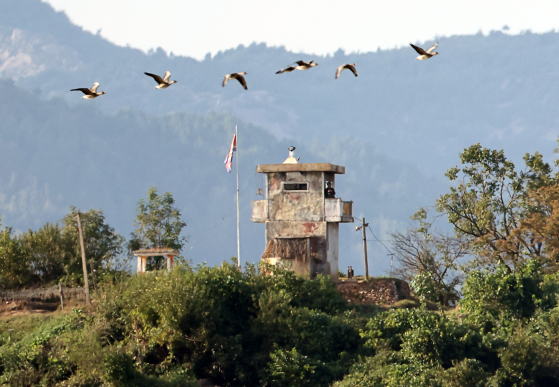North Korea’s military announced via state media that it will begin severing all overland connections to South Korea on Wednesday.
In a report carried by Pyongyang’s state-controlled Korean Central News Agency (KCNA), the general staff of the Korean People’s Army (KPA) said it plans to launch a project on Oct. 9 “to completely cut off roads and railways” to the South and “fortify the relevant areas of our side with strong defense structures.”
The KPA general staff characterized the measures as “self-defensive” in nature and aimed at “inhibiting war and defending the security” of the North against South Korea, which it described as its “primary hostile state and invariable principal enemy.”
The KPA’s description of the South mirrored the shift in North Korean leader Kim Jong-un’s view of South Korea, which he characterized as the North’s primary foe in a speech before the regime’s rubber-stamp parliament in January.
The KCNA report on the construction of fortifications blocking overland connections to the South came two weeks after Voice of America (VOA) reported the North had constructed three to four “large-scale” barrier walls to block traffic on the road that runs along the Gyeongui Line connecting Seoul to Kaesong.
According to VOA’s analysis of satellite images taken by Planet Labs, the walls are set approximately 15 meters (49.2 feet) apart and span the entire 20-meter width of a road segment located approximately 320 meters north of the military demarcation line (MDL), which constitutes the de facto inter-Korean boundary.
In Wednesday’s KCNA report, the KPA general staff said it sent a telephone message to the U.S. military in South Korea at 9:45 a.m. to “prevent any misjudgment and accidental conflict” over the ongoing construction work.
![North Korean soldiers are seen working along the inter-Korean border in this photograph from the Odusan Unification Observatory in Paju, Gyeongggi, on Wednesday. [YONHAP]](https://koreajoongangdaily.joins.com/data/photo/2024/10/09/bf45f81d-6257-4388-a489-1c0e4adadf7a.jpg)
Seoul suspended its participation in a 2018 inter-Korean military agreement designed to reduce the risk of accidental clashes in June after Pyongyang launched hundreds of trash-laden balloons across the border and jammed GPS signals along the demilitarized zone that divides the peninsula.
The South has since resumed large-scale military exercises, including live-fire artillery drills, in areas where they had been proscribed under the deal, while the North has continued to send trash-laden balloons into the South.
The regime’s state media also reported last month on Kim’s visit to a previously undisclosed uranium enrichment facility, where he called for an expansion of the number of centrifuges to increase the amount of fissile material to build nuclear weapons.
South Korean military intelligence told lawmakers on Tuesday the North appears to be building nuclear-powered submarines in Sinpo, South Hamgyong Province, which is home to the regime’s submarine-related facilities.
Nuclear-powered submarines would represent a leap in North Korea’s strategic planning as they would give the country second-strike capability, or the ability to mount a retaliatory nuclear strike even after suffering an initial attack.
BY MICHAEL LEE [lee.junhyuk@joongang.co.kr]





